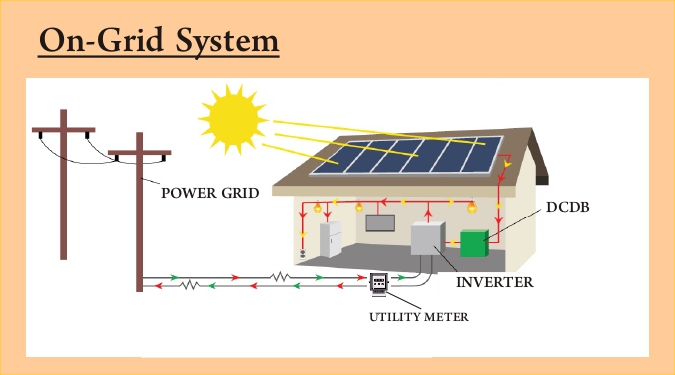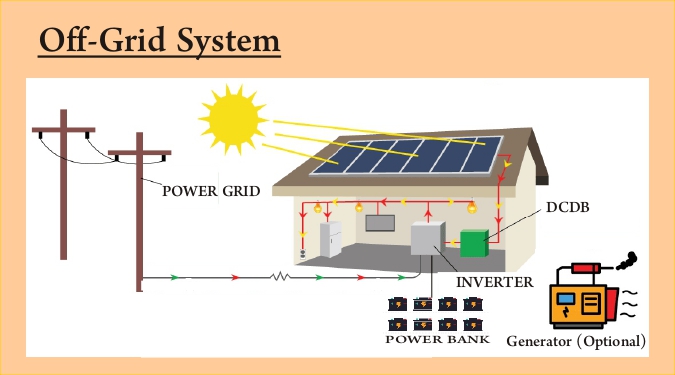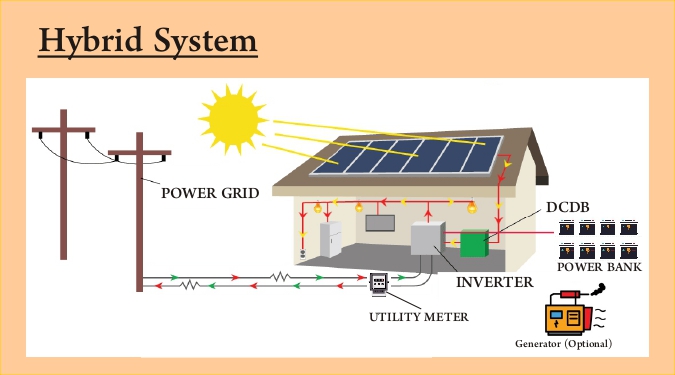


When you want to have Solar Rooftop Systems for home, office or industry, often there is confusion on different kinds of Solar Rooftop solutions. Selecting the right kind of Solar Rooftop system is essential.
Solar lasts many years, hence a wrong decision can be very painful. 𝘋𝘪𝘥 𝘺𝘰𝘶 𝘬𝘯𝘰𝘸 𝘵𝘩𝘢𝘵 73.6% 𝘰𝘧 𝘵𝘩𝘦 𝘴𝘰𝘭𝘢𝘳 𝘣𝘶𝘺𝘦𝘳𝘴 𝘨𝘦𝘵 𝘴𝘵𝘶𝘤𝘬 𝘸𝘪𝘵𝘩 𝘵𝘩𝘦 𝘸𝘳𝘰𝘯𝘨 𝘴𝘺𝘴𝘵𝘦𝘮 or wrong capacity of the solar power systems. 𝘣𝘦𝘤𝘢𝘶𝘴𝘦 𝘵𝘩𝘦𝘺 𝘢𝘳𝘦 𝘯𝘰𝘵 𝘧𝘶𝘭𝘭𝘺 𝘢𝘸𝘢𝘳𝘦 𝘰𝘧 𝘵𝘩𝘦 𝘵𝘦𝘤𝘩𝘯𝘰𝘭𝘰𝘨𝘺 𝘵𝘩𝘢𝘵 𝘧𝘪𝘵𝘴 𝘵𝘩𝘦𝘪𝘳 𝘯𝘦𝘦𝘥𝘴. Hence, it is important to understand the different kinds of solar rooftops and their pros & cons to taking an informed decision.
But before we move to different kinds of Solar Rooftops let’s understand the main components used in a solar rooftop:
Components of a Solar Rooftop System
1. Modules/Panels – Modules or PV panels are the Solar electricity generator of the solar power system. Solar panels convert sunlight into direct current (DC) electricity. Three basic types of modules are there in the marketplace: Mono crystalline, Multi crystalline and thin film.
2. Array – Several modules connected to a system are called Array.
3.Grid Tie Inverter – Grid Tie Inverter are used in the Grid Tie Solar (also known as On-grid solar) Power systems. It converts DC to AC and feeds the utility grid with the A/C power
4. PCU- Power Conditioning Unit or PCU is used in the battery-based system (off-grid solar systems). The Solar PCU controls the priority and optimally selects the source of charging. It also selects the source of AC output to be either from the Solar or inverter or the grid. It has a user selectable energy saver mode which allows the user to select the priority and save the bill. The main focus here is to save the electricity bill cost. In the Energy Saver Mode priority is given to Solar, the battery is charged first and also supports the inverter to power the appliances.
5. MPPT– Maximum power point tracker or MPPT, is a type of solar charge controller. A solar charge controller is needed in solar rooftops to regulate the power going from the solar panels. MPPT solar charge controllers maximize the energy from the Panel.
6. Batteries – stores DC power used for off-grid systems /storage systems
Now that you have understood the components used in the solar rooftops, let’s understand the different kinds of systems and their pros & cons.
Kinds of Solar Rooftop Systems

1. Grid-Tied Solar Rooftop System or On-Grid System
Pros:
- It doesn’t require a battery system and hence is less expensive.
- It gives the best value for money, the investments get recovered within 5-8 years and for the rest of life (17-20 years), it gives free power, giving high returns on investment on solar.
- Net Metering allows the electricity generated by a solar system to offset the electricity used from the grid during the night or cloudy days.
- Grid-connected systems don’t need segregation of critical load and non-critical load. Critical Load means the load needs to power up when grid power is not available
Cons:
- Grid-connected batteries don’t have batteries. So there is no battery backup when grid power or solar power is not available.
- If the grid power goes, the system will shut down. This is done to prevent energy from back feeding to the grid to keep the workers working on the grid safe.

2. Stand Alone System or Off-Grid Solar Rooftop
This kind of Solar Rooftop System incorporates battery storage to provide power during power outages. It may require a large battery if the backup has to be given for a certain number of days (and nights) in a row when the sun is not available. The array of solar panels must be large enough to power all energy needs at the site and recharge the batteries at the same time. . A standby diesel generator can be employed for emergency backup power. It does not supply surplus energy to the grid and net metering is not applicable.
Pros:
- Most of them have an isolation transformer, thereby providing pure sine wave and galvanic isolation from the input.
- It provides backup power when most needed. It saves on the electricity bill by providing solar energy during the day time and not consuming grid energy.
Cons:
- It is more costly due to the inclusion of a battery and isolation transformer.
- The surplus energy produced goes wasted.
- The batteries need to be replaced every 4 or 5 years.
- It is not reliable during cloudy days and nights for providing electricity.
- It requires the load to be segregated into the critical and non-critical load.
- The inductive loads such as Induction Motors, Conventional Air conditioners, the compressor generally can not be connected with an off-grid system

3.Hybrid Rooftop System or GRID-TIE with Battery Backup System:
It is a grid-tie system with batteries for providing backup in case of a power outage. The Hybrid system can also push excess electricity produced to the electric utility grid. It is a combination of Grid Connected and off-grid systems that can connect to the grid and provide battery backup during non-availability of the grid. With this benefit comes increased cost and maintenance requirements.
Pros:
- Uses the advantages of both off-grid and on-grid systems.
- Continuous power supply – The hybrid solar systems provide power continuously, without any interruption, as the batteries connected to them store the energy. So, when there is an electricity outage, the batteries work as an inverter to provide you backup. This is also the case during the evening or night time when there is no sun and energy is not being generated; batteries provide the back-up and life goes on without any interruption.
- Utilize the renewable sources in the best way – Because the batteries are connected to the system to store the energy, there is no waste of the excess energy generated on bright sunny days. So, these systems make use of renewable energy in the best way, storing energy on a good day and utilizing the stored power on a bad day. The balance is maintained.
- Low maintenance cost – The maintenance cost of the hybrid solar energy systems is low as compared to the traditional generators which use diesel as fuel. No fuel is used and they do not require frequent servicing.
- High efficiency – The hybrid solar energy systems work more efficiently than your traditional generators which waste the fuel under certain conditions. Hybrid solar systems work efficiently in all types of conditions without wasting fuel.
- Load management – Unlike traditional generators, which provide high power as soon as they turn on, most of the hybrid solar power systems manage load accordingly. A hybrid solar system may have technology that adjusts the energy supply according to the devices they are connected to, whether it’s an air conditioner requiring high power or a fan which requires less.
Cons:
- High installation cost – Although the maintenance cost is low, the initial investment for the installation of hybrid solar energy systems is high as compared to solar systems.
- Less battery life – The batteries connected to the system may have a lower life as they are often exposed to natural elements like heat, rain, etc.
- The number of instruments connected has to be divided into critical/semi-critical and noncritical– The load has to be divided into the above three categories. It will cut off non-critical load first, then semi-critical and critical in the last, depending on the power available.
Now that you have understood each kind of Solar Power system, you must have got a fair idea of which kind of solar rooftop is most suitable for you.
We are summarizing below the kind of solar rooftop to opt for further clarity.
Which Type of Solar Rooftop System should you choose?
Now that various kinds of Solar Rooftop system are understood, we will delve into which kind of system to choose depending on the requirement:
Choose a Grid-tied System:
- If the grid power supply is reliable and rarely shuts down, then on-grid is a good choice as it will give large savings on the grid power bill.
- Where the electricity bill constitutes major costs and the intention is to reduce the electricity bill. It gives the best return on investment and is the most economical
Choose an Off-Grid System:
- If the power is erratic and power back-up is required during power shutdowns for the critical loads.
- In the daytime, even if the grid power is available the critical loads are powered by solar energy. This causes savings in the electricity bills.
- It is most useful for residence, institutions and industries where the power need is not very large.
- Investment is lower to the Hybrid System by 25% to 30%
Choose a Hybrid System:
- It can optimize the energy consumption, supplying the power to the grid when not needed and to the load when needed. It will reduce the electricity bill and also provide power during power breakdowns.
- It can distribute power based on priority parameters. For eg. at 70% of battery charge, it can disconnect the low priority load and at 50% it can disconnect further low priority load.
- It can provide grid reference to the grid-tied inverters, called AC-coupling. This enables excess power to be transferred to the grid.
- It can sync with the DG and auto start/stop it when needed. Causes huge savings in the Generator load.
- In smart boost mode, it can synchronize with the DG/Grid and provide a power which is a summation of input source and inverter power. For eg., if the solar Inverter is of 5 KVA and DG of 4 KVA. It can give the output of 5KVA + 4KVA= 9KVA.
- It can work on inductive loads like Motor, Lifts, conventional AC’s etc.
You might still be having some specific doubts about the solar power system. We are covering below the common questions being asked and the answer to them below.
FAQ’s on Solar Rooftop System
1.What is Net Metering?
Net metering is a billing mechanism in which kilowatt-hour (KWh) energy produced by the solar power is subtracted from the units consumed and only the differential units bill is raised. If some excess power is generated in some months, it gets credited and adjusted in the subsequent bill. This applies to grid-tied solar power systems.
2.What do you mean by PV in a Solar Rooftop System?
PV or Photovoltaics is a common word when someone is discussing solar energy. Photovoltaics means ‘electricity from light’. It is the method of creating electricity from solar (sun) radiation through the use of solar modules.
3.Can a Grid-tie Inverter (On-grid inverter) work without Grid supply?
No, grid with correct voltage and frequency range is required for the proper functioning of Grid Tie Inverter (GTI)
4. Can I connect a diesel generator to create a grid for Grid Tie Inverter to work?
We cannot pump power to a generator under normal conditions and doing so will spoil the generator. Moreover, while the Grid Tie Inverter (GTI) pumps power to the generator its frequency and voltage will be unstable which makes the GTI back off.
The DG, however, can be used during grid failure under certain conditions.
- If the DG rating >1.5 times the solar array capacity.
- If the DG with the Grid Tie Inverter by adopting RPR (Reverse Power Relay) and Power Manager software.
5. How much money do I get if I supply power to the Grid?
The rate of buying power from the solar power plants is fixed by the state electricity board and depends on the state top state, please consult your local electricity supply company.
6. What if there is a shadow on the roof, how much will be the energy loss.?
Partial shadow will do more harm to the panels than full shadow. There must be a shadow-free area between 9 AM to 3 PM for best performance.
7. What if we already have an inverter with the battery at home, should that be removed for installing a Grid Tie Inverter?
The existing inverter is in no way connected to GTI. GTI will stop when the grid fails, your the existing inverter will start supplying power when the grid fails.
8. Can the GTI be synched to an inverter?
No, GTI cannot feed power to an inverter at all.
9. Which season of the year do we get more power from the panels?
Solar panel output depends on temperature and radiation. Ideally low temperature
with a clear sky produces better output than summer where the heat is more.
10. Should the grid-tie inverter (GTI) be operated every day?
No, the GTI will turn On when the solar panels produce power and turn OFF in the evening when the sunsets. No manual operation is required.
11. What should be done when we are not at home for many days? Should the GTI be disconnected and turned OFF?
No. The unit will export all the power produced when there is no load in the house.
12. How much power will the GTI consume during the night?
There will be 4-5 W consumption during the night as the GTI will work only during the day when solar power is available.
13. What is the regular maintenance required?
a. Clean the solar modules regularly depending on the dust accumulation on the panels.
b. Wipe any dust accumulation on the GTI, do not use a wet cloth.
c. Ensure electrical connections are secure and checked once in six months.
d. Allow adequate airflow around the GTI so that it is cool.

